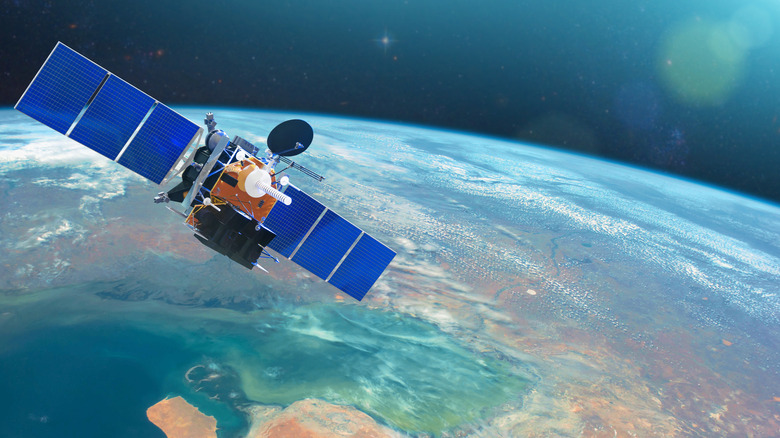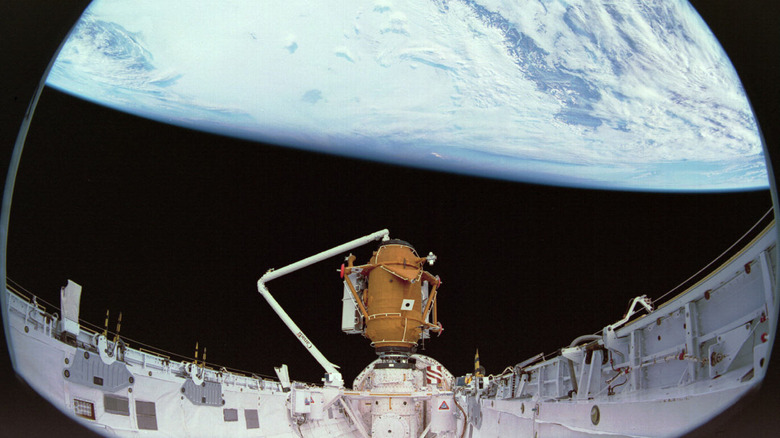The Difference Between The Three Main Satellite Types
Satellites run your life. Orbiting communication satellites handle everything from navigation to the nearest Wendy's to the transmission of vital scientific data and the transactions of global commerce. But how do they, you know, work? Let's start with a definition. For our purposes, a satellite is fundamentally a space-based communications system that orbits the Earth and transmits information, both to and from the planet and among other satellites. Those communications are vital to every kind of space operation, as well as many Earthbound endeavors.
There are other kinds of satellites — in dictionary terms, the word satellite just means "a thing orbiting Earth" — but for our purposes, the word satellite refers to communications satellites, which tend to have the most noticeable effects down here on the blue marble. Satellites split into three categories based on their orbit: low-Earth orbit, medium-Earth orbit, and geostationary-Earth orbit. Those terms imaginatively shorten down to the acronyms LEO, MEO, and GEO.
Low-Earth orbit (LEO) satellites
Any man-made object meant to stay in low-Earth orbit is an LEO satellite. Per the European Space Agency, "low-Earth orbit" is 1,000 kilometers (621 miles) or closer, ranging to as close as 160 kilometers (99.5 miles) in special cases. For reference, the average airliner cruises at an altitude of between 6 to 8 miles above sea level (via Pilot Institute), so they're only close in the astronomical sense. Nobody's in danger of bumping their head on a satellite.
For most LEO satellites, being close to the surface is a feature, not a bug. LEOs take the best satellite images and support surface-level services like broadband internet. The short distance also means short ping times, so fast, low-latency data is also the province of LEO satellites. The next time you land a noscope headshot on a friend or loved one while gaming over something like Starlink, thank LEOs.
Since LEOs move quickly across Earth's surface compared with things on larger loops, single LEO satellites have limited utility in communications. Instead, they tend to come in constellations, which the IAU and other authorities define as networks of LEO satellites linked to one another and designed to handle data over a large area of the Earth. Unlike GEO and MEO satellites, LEOs orbit close enough that their orbits can change from one rotation to the next, a quality used by engineers and astronomers to maximize global coverage.
Medium-Earth orbit (MEO) satellites
MEOs are, go figure, medium-Earth orbit satellites. MEO range is generally between 5,000 and 20,000 kilometers (3,107 to 12,407 miles), but the only formal definition is that MEO falls between LEO, which tops out at 1,000 kilometers, and geostationary. Medium-Earth orbit satellites are comparatively less common than either LEOs or geostationary satellites, but they're also vitally important. These satellite networks are the primary basis of GPS, according to Satellite Today. Everything from jogging apps to aircraft carriers rely on MEO satellites to tell them where they are and where they're going.
MEOs are also important scientific and government tools, tasked with transmitting high-bandwidth, low-latency data with minimum possible loss rate. As Capacity Media notes, raw data for scientific studies, deep background for political and military decisions, careful observation of global phenomena like climate and international travel, and other applications where data quality takes precedence over speed rely on MEO transmission.
Geostationary-Earth orbit (GEO) satellites
Geostationary-Earth orbit satellites, or GEO satellites, differ in many ways from LEOs and MEOs. Beyond the sheer distance of their orbit — 35,786 kilometers (22,236 miles) – they interact with the Earth differently and serve different functions. First, note that orbit. While LEOs and MEOs get a range, GEOs have to orbit at exactly 35,786 kilometers because their orbit has to take exactly one sidereal day (via Swinburne University of Technology). At that distance, GEO satellites remain in one place relative to the surface of the Earth, observing the same spot at all times as the satellite and the planet roll through their respective rotations.
GEO satellites have a variety of uses. Comparatively, long-distance means comparatively long lag times, so any data requiring a quick response is better served by LEOs and MEOs. Instead, GEOs excel at large-scale, long-term observation. Weather forecasting depends on GEOs, for example. GEO constellations also collect and transmit data for weather, climate, and geological science. Finally, as noted by NASA, GEO satellites enable communication between the Earth and other orbiting objects, such as manned spacecraft and space telescopes.



